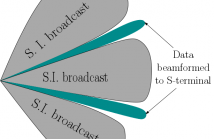
The 19th IEEE International Workshop on Signal Processing Advances in Wireless Communications, SPAWC 2018, will be held in Kalamata, Greece, June 25-28, 2018. The workshop is devoted to advances in signal processing for wireless communications, networking, and information theory. The technical program features plenary talks, tutorials, as well as invited and contributed papers presented in poster format.


This work proposes a real-time movement control algorithm for massive unmanned aerial vehicles (UAVs) that provide emergency cellular connections in an urban disaster site. While avoiding the inter-UAV collision under temporal wind dynamics, the proposed algorithm minimizes each UAV’s energy consumption per unit downlink rate. By means of a mean-field game theoretic flocking approach, the velocity control of each UAV only requires its own location and channel states.
SPAWC 2018.pdf
- Categories:
 24 Views
24 Views
- Read more about Information Aging through Queues: A Mutual Information Perspective
- Log in to post comments
MIposter.pdf
- Categories:
 3 Views
3 Views
- Read more about Information Aging through Queues: A Mutual Information Perspective
- Log in to post comments
MIposter.pdf
- Categories:
 9 Views
9 Views
- Read more about Efficient Techniques for Broadcast of System Information in mmWave Communication Systems
- Log in to post comments
In this paper we consider Millimeter wave (mmWave) Massive MIMO systems where a large antenna array at the base station (BS) serves a few scheduled terminals. The high dimensional null space of the channel matrix to the scheduled terminals is utilized to broadcast system information to the non-scheduled terminals on the same time-frequency resource.
- Categories:
 46 Views
46 Views
- Read more about Efficient Techniques for Broadcast of System Information in mmWave Communication Systems
- Log in to post comments
In this paper we consider Millimeter wave (mmWave) Massive MIMO systems where a large antenna array at the base station (BS) serves a few scheduled terminals. The high dimensional null space of the channel matrix to the scheduled terminals is utilized to broadcast system information to the non-scheduled terminals on the same time-frequency resource.
- Categories:
 27 Views
27 Views
- Read more about A Constant-Gap Result on the Multi-Antenna Broadcast Channels with Linearly Precoded Rate Splitting
- Log in to post comments
In this paper, we consider a simple downlink channel with a multi-antenna base station and two single-antenna receivers. We assume that the channel is deterministic and known to all the nodes. Our contribution is two-fold. First, we show that linear precoding with private streams can have unbounded gap to the capacity of the channel. Second, we show that using rate-splitting with a simple power allocation one can achieve the sum capacity to within a constant gap for any channel realization.
- Categories:
 8 Views
8 Views
- Read more about Trajectory Optimization for Autonomous Flying Base Station via Reinforcement Learning
- Log in to post comments
In this work, we study the optimal trajectory of an unmanned aerial vehicle (UAV) acting as a base station (BS) to serve multiple users. Considering multiple flying epochs, we leverage the tools of reinforcement learning (RL) with the UAV acting as an autonomous agent in the environment to learn the trajectory that maximizes the sum rate of the transmission during flying time. By applying Q-learning, a model-free RL technique, an agent is trained to make movement decisions for the UAV. We compare table-based and neural network (NN) approximations of the Q-function and analyze the results.
- Categories:
 16 Views
16 Views
Much of security research focuses on preventing an adversary from deciphering a message's content, but there are a number of applications that motivate the more challenging goal of ``covert'' communications: transmitter Alice conveying information to legitimate receiver Bob while preventing a capable and attentive adversary Willie from detecting the presence of the message.
- Categories:
 16 Views
16 Views